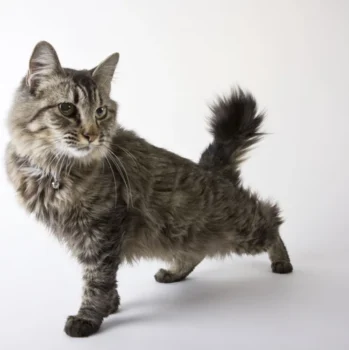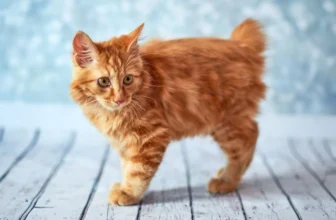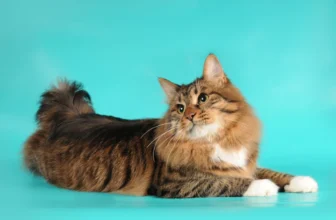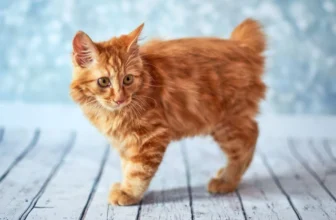As any feline enthusiast knows, American Bobtails are an incredibly unique breed with striking physical features. One of their most fascinating characteristics is their coats, which boast a range of patterns and colors that make them truly stand out from the crowd. For those who have ever wondered about the science behind these intricate markings or how to properly care for them, this article will provide a detailed guide to the different coat patterns of American Bobtails, the factors that affect their appearance, and tips for keeping them healthy and beautiful. So, whether you’re a seasoned American Bobtail owner or simply a curious admirer, read on to discover the secrets behind these uniquely stunning felines.
The Genetics Behind American Bobtail’s Coat Patterns
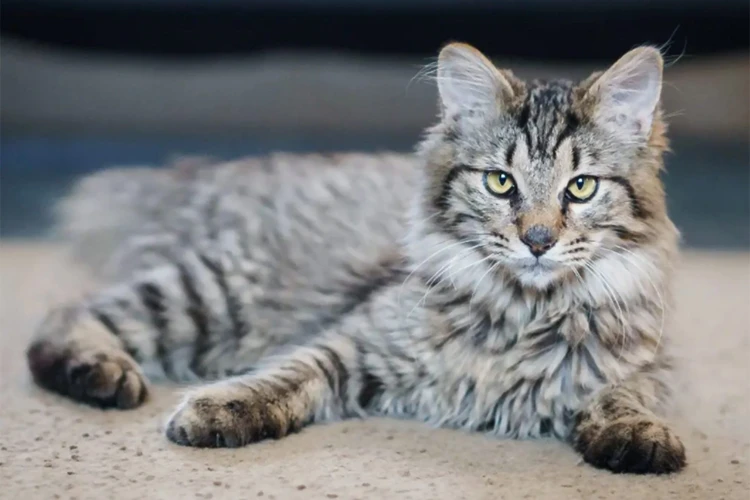
Understanding the unique coat patterns of American Bobtails begins with comprehending the genetics behind it. American Bobtails have a wide range of coat patterns that make them stand out from other feline breeds, and they inherit these patterns in a particular way. The genes that determine coat patterns are distinctive, and it’s intriguing how they shape the physical appearance of these cats. Let’s delve into the extraordinary world of American Bobtail genetics to understand how their coat patterns come to be. (You can learn more about American Bobtails’ muscular build in this article.)
Dominate and Recessive Genes
In the world of genetics, understanding dominant and recessive genes is essential in comprehending how traits, including coat patterns in American Bobtails, are inherited. Dominant genes are the genes that will always be expressed and mask recessive genes. On the other hand, recessive genes are only expressed when two copies are present.
To illustrate, let’s say that the gene for the classic tabby coat pattern in American Bobtails is dominant, and a parent with a classic tabby coat pattern has one dominant gene and one recessive gene. If this parent pairs with another American Bobtail with a recessive gene for the classic tabby coat pattern, each kitten in their litter has a 50% chance of inheriting the classic tabby coat pattern, regardless of whether the other parent has a dominant or recessive gene for the same trait.
For American Bobtails, the inheritance of coat patterns is not a linear process, and there are several unpredictable factors involved. Nonetheless, having an understanding of the dominant and recessive genes responsible for coat patterns can help breeders selectively propagate specific traits.
If you’re interested in learning more about American Bobtails, be sure to read our related articles on their short tails, strong legs, polydactyl paws, body shape and health, and striking eyes.
Unpredictable Traits
As previously mentioned, the coat patterns of American Bobtails are determined by a variety of genes, including dominant and recessive traits. However, there are also unpredictable traits that can affect the appearance of their coat. These traits can make it difficult to predict the exact coat pattern that an American Bobtail will develop.
One unpredictable trait is polygenetic inheritance, which means that multiple genes are involved in determining a single trait. This can lead to a wide range of variations, even within the same litter of kittens. For example, two kittens from the same parents can have different coat patterns even though they possess some of the same genes.
Another unpredictable trait is somatic mutations, which occur after the fertilization of an egg. These mutations can result in small patches of different colors or coat patterns appearing on an American Bobtail’s fur, creating a unique and unusual appearance.
Additionally, environmental factors and interactions with other cats can also affect the appearance of an American Bobtail’s coat over time. Poor nutrition, stress, or illness can lead to changes in the texture and thickness of their fur, while regular grooming and a healthy diet can help maintain a shiny and healthy coat.
Table:
| Unpredictable Traits: | What it Means: |
|---|---|
| Polygenetic Inheritance | Multiple genes determine a single trait leading to variations |
| Somatic Mutations | Mutations after fertilization lead to small patches of different colors or coat patterns |
| Environmental Factors | Poor nutrition, stress, or illness can affect coat texture and thickness |
| Interactions with Other Cats | Can lead to changes in coat appearance over time |
While there are certain genes that determine the coat patterns of American Bobtails, there are also unpredictable traits and environmental factors that can influence the appearance of their fur. It’s important to provide proper care and nutrition to help maintain a healthy and beautiful coat, while also appreciating the unique and individual traits that make each American Bobtail special.
The Different Coat Patterns of American Bobtails
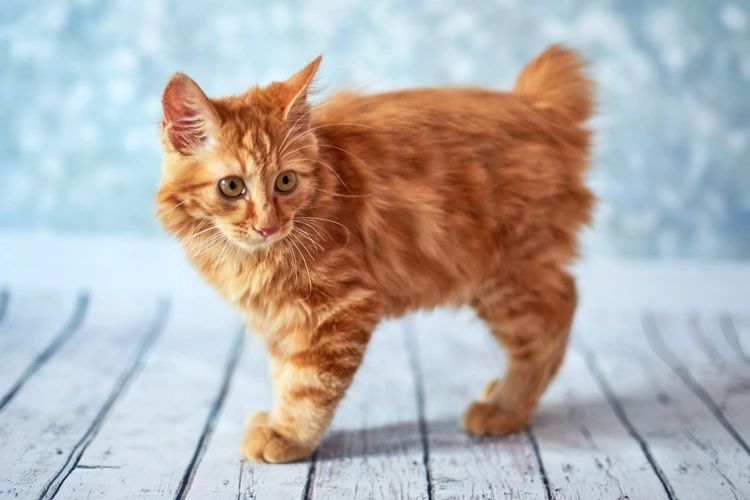
A true hallmark of the American Bobtail is their unique coat patterns. Each one, from classic tabby to bi-color or solid color, is just as distinct and striking as the next. A glance at any American Bobtail and one can’t help but marvel at the intricate designs and color combinations that make up their coats. But how are these distinctive patterns formed? Let’s delve deeper into the fascinating world of American Bobtail coat patterns.
Classic Tabby
The Classic Tabby is the most well-known and recognizable coat pattern of the American Bobtail breed. This pattern is characterized by bold, swirling stripes that run down the cat’s body, forming a “bullseye” on the cat’s side.
The Genetics of Classic Tabby Pattern
The Classic Tabby pattern is a dominant trait, meaning that if a cat inherits the gene for the pattern from just one parent, it will display the pattern. This pattern is also referred to as “blotched tabby,” as the stripes are larger and more spacious than those in other tabby patterns.
To better understand the genetics of Classic Tabby pattern among American Bobtails, refer to the following table:
| Genotype | Phenotype |
|———-|———–|
| AA | Classic Tabby |
| AB | Classic Tabby |
| BB | Not Classic Tabby |
In this table, A represents the dominant allele for Classic Tabby pattern, while B represents the recessive allele for the pattern.
Unique Characteristics of Classic Tabby Pattern
One of the interesting characteristics of Classic Tabby pattern in American Bobtails is that while the pattern is meant to be symmetrical, it doesn’t always appear that way. The pattern may be slightly off-center or one side of the cat’s body may be more heavily patterned than the other.
Additionally, some Classic Tabby American Bobtails may have a distinctive “M” shape on their forehead, which is a common characteristic of the tabby pattern in general.
The Classic Tabby pattern is a beloved and classic look for American Bobtail cats. Its bold stripes and unique characteristics make it a recognizable and popular coat pattern within the breed.
Marbled Tabby
The Marbled Tabby pattern in American Bobtail cats is a striking and unique coat pattern that is as beautiful as it is rare. This coat pattern is also known as the Classic Marble Tabby or the Bull’s Eye Tabby due to its distinctive bull’s eye swirls and marbled markings.
The Marbled Tabby pattern is created by having both solid and broken lines on the cat’s coat. The pattern is categorized by a light or white undercoat with dark contrasting patches, resulting in a marble-like appearance. The curl of each hair helps create the swirling pattern, giving each American Bobtail cat a unique appearance.
The Marbled Tabby pattern is a product of genetics, and it is important to understand that its unique appearance comes from random mutations during the cat’s development process. A cat that carries the Marbled Tabby pattern must inherit the gene from both parents to exhibit the marbled coat pattern.
This coat pattern can come in different colors such as brown, blue, silver, and red. Each color variant is unique to the breed and the individual cat. The Marbled Tabby pattern also comes in different shades, from dark rich tones to lighter almost pastel shades.
In terms of personality, American Bobtails that have the Marbled Tabby pattern are known for being affectionate, playful, and lively. They are playful and inquisitive by nature, making them a great companion for families with children.
To ensure their coat stays healthy and vibrant, it is important to provide proper grooming, diet, hydration, and shelter. Providing a balanced diet with essential fatty acids and omega-3s can help maintain the natural oils in your cat’s coat, keeping it silky and smooth. Regular grooming, including brushing and combing, can help keep the coat clean and free from matting. With its unique pattern and personality, the Marbled Tabby is a sought-after breed for those who want a pet with a bit of individuality.
Below is an HTML table summarizing the characteristics of American Bobtails with Marbled Tabby pattern:
| Pattern | Marbled Tabby |
| Coat Appearance | Bulls-eye swirls and marbled markings |
| Color Variants | brown, blue, silver, and red |
| Shade Variants | light and dark shades |
| Personality | affectionate, playful, and lively |
Spotted Tabby
The Spotted Tabby coat pattern is another unique and stunning feature of American Bobtails. In this type of coat pattern, the fur has spots all over the body. However, the spots may be small or large, irregular or uniform in shape. The background coat color can be anything from white to black.
The Genetics Behind Spotted Tabby Pattern
The Spotted Tabby coat pattern is created by the Ticked tabby gene (Ta) and the Agouti gene (A). The Ta gene causes the ticking or flecking effect in the fur, while the Agouti gene determines the distribution of pigment in the fur. The Spotted Tabby pattern is formed when the ticking is visible on the lighter background coat color, creating spots.
Distinctive Features
It is important to note that each American Bobtail cat’s coat pattern is unique, and that holds true for Spotted Tabby as well. The spots in this pattern may be of different sizes and shapes, creating an irregular and unique pattern. The spots may also be of different colors against the background coat color. A Spotted Tabby American Bobtail’s face may have spots as well, creating a distinct facial pattern.
Care Instructions
To keep your Spotted Tabby American Bobtail’s coat healthy and shiny, regular grooming is essential. Use a brush or comb that is suitable for your cat’s coat type and grooming needs. Feeding your cat a high-quality, balanced diet and ensuring they stay hydrated by providing plenty of fresh water will also help maintain their coat’s health. Finally, providing a clean and comfortable living environment will help prevent any external factors that may affect the appearance of their coat, such as fleas or ticks.
The Spotted Tabby coat pattern is a beautiful and unique characteristic of the American Bobtail breed. Its distinctive features make it one of the most eye-catching and visually appealing patterns in the cat world.
Patched Tabby
The Patched Tabby coat pattern is also known as the Tortoiseshell Tabby pattern. It is a unique and striking coat pattern that features a combination of tabby markings and patches of solid color.
This coat pattern is more common in female American Bobtails due to the genetics of the trait. The Patched Tabby pattern is the result of the interaction between the X chromosomes and the orange tabby gene. As female American Bobtails have two X chromosomes, they can inherit one orange tabby gene from each parent, resulting in the Patched Tabby pattern. Male American Bobtails, on the other hand, have only one X chromosome, so they can only inherit one orange tabby gene, resulting in either orange tabby or non-orange tabby patterns.
The Patched Tabby pattern can come in a variety of colors including black, red, cream, and blue. The pattern may also feature white patches or have a brindle-like appearance. The patches of color can be irregular in shape and size, giving each American Bobtail with this coat pattern a truly unique appearance.
Interestingly, the Patched Tabby pattern can change over time. As American Bobtails with this coat pattern age, their fur may develop more solid patches or the tabby markings may become more prominent. The patches may also become more muted or fade, creating a subtle and beautiful variation in the coat pattern.
When taking care of an American Bobtail with a Patched Tabby pattern, it’s important to pay attention to any changes in their coat appearance. Regular grooming can help prevent matting of the fur and maintain the unique appearance of the coat pattern. A balanced diet and adequate hydration can also contribute to a healthy and shiny coat.
The Patched Tabby coat pattern is a remarkable and fascinating trait that adds to the beauty and individuality of the American Bobtail breed. It’s important to understand the genetics behind this coat pattern and to properly care for an American Bobtail with this trait to maintain their unique appearance.
Bi-color
American Bobtails’ bi-color coat pattern is a striking combination of two contrasting colors that creates a unique and eye-catching appearance. This coat pattern is characterized by one color being dominant and covering most of the cat’s body, while a second contrasting color is present on the face, paws, and tail.
The dominant color of the bi-color American Bobtail can range from black to brown to even shades of blue, cream, and red. Meanwhile, the contrasting color can appear in a variety of shades, such as white, cream, or red. This combination of colors creates a striking and dramatic appearance that is sure to turn heads.
Although bi-color coat patterns can occur naturally, breeders often breed for this specific trait to produce American Bobtails with this unique coat pattern. Due to the genetics behind coat patterns, it can sometimes be unpredictable how the bi-color pattern will turn out in a litter of kittens.
Factors such as age, gender, and environment can all play a role in the appearance of an American Bobtail’s bi-color coat pattern. The bi-color pattern may also change over time due to seasonal changes, with some cats becoming more or less pigmented depending on the time of year. This can add even more uniqueness and complexity to the American Bobtail’s coat pattern.
As with all coat patterns, proper care and maintenance is essential to keeping an American Bobtail’s bi-color coat looking its best. Regular grooming, including brushing and bathing, can help to keep a cat’s coat healthy and shiny. Meanwhile, providing a balanced and nutritious diet, plenty of hydration, and a comfortable and safe shelter can all contribute to a cat’s overall health and appearance.
The bi-color coat pattern of American Bobtails is a fascinating and striking example of the genetic diversity of this unique breed. Whether you are an American Bobtail owner or simply appreciate their fascinating coat patterns, knowing more about their bi-color pattern can help you understand and appreciate these remarkable feline companions even more.
Solid Color
Solid color coat patterns in American Bobtails are unique in their own way. These coats are characterized by a single color throughout the body of the cat. The colors of solid coats may vary from white, cream, black, blue, or chocolate.
Ancestry plays a vital role: The solid coat patterns of American Bobtails are primarily determined by the cat’s ancestry. A solid coat pattern is dominant over all other patterns. If both parents have solid coats, their offspring are more likely to have a solid coat pattern as well.
Color variations: The solid coat pattern comes in a variety of colors, ranging from traditional black to chocolate, cream, and white. According to the International Cat Association (TICA), over 60 different color variations are possible in the American Bobtail solid coat pattern.
To make it easier to understand, here’s a table showing some of the possible combinations of solid coat color with eye color in American Bobtails:
| Solid Coat Color | Eye Color |
|---|---|
| White | Blue, Odd-Eyed, Copper, or Green |
| Cream | Blue, Odd-Eyed, Copper, or Green |
| Black | Odd-Eyed, Copper, or Green |
| Blue | Odd-Eyed, Copper, or Green |
| Chocolate | Odd-Eyed, Copper, or Green |
Maintenance is essential: Maintaining the solid color of an American Bobtail’s coat is vital. These cats tend to shed their fur throughout the year, so regular grooming is necessary to avoid matting and tangling of their hair. Owners must use the right grooming tools, such as a slicker brush or a metal comb, to reduce shedding.
The importance of diet: A proper diet is essential in maintaining the American Bobtail’s solid coat pattern. A high-quality diet rich in protein and vitamins will help keep their coat healthy and shiny. Lack of proper nutrition may result in dull coat color and texture.
Solid coat patterns in American Bobtails are unique, and their color may vary depending on the cat’s ancestry. It is essential to take good care of their coat through regular grooming and proper nutrition, maintaining its shine and texture.
Factors That Affect the Appearance of American Bobtails’ Coat
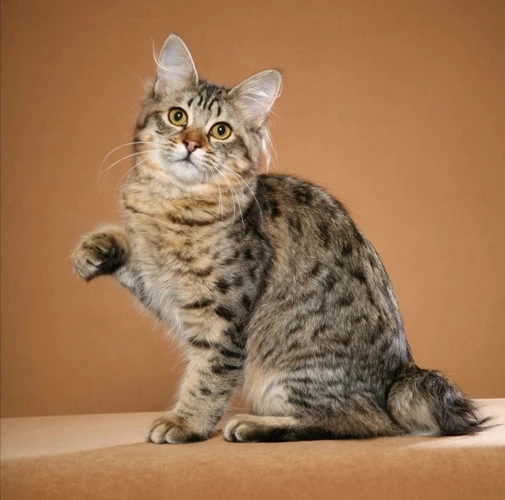
While American Bobtails do have some predisposed coat patterns based on their genetics, there are a multitude of factors that can affect the appearance of their coats. From age to gender to environmental factors, these variables can play a role in shaping the final look of your pet’s coat. So, if you’re a proud owner of an American Bobtail, it’s important to be familiar with these factors and how they can influence your cat’s fur. Let’s take a closer look at some of the most significant factors that affect the appearance of these cats’ coats.
Age
Age and Its Effect on American Bobtails’ Coat Patterns
The age of American Bobtails plays a vital role in the evolution of their coat patterns. Like any other breed of cats, their physical traits change as they grow older. The coat patterns that are known to emerge during the first year of their life might change or evolve into something entirely different as they reach adulthood.
Here are a few changes that you might notice:
| Age | Changes in Coat Patterns |
|---|---|
| Newborn | American Bobtails are usually born with fur that is soft and short with an indistinct pattern. At this stage, it’s impossible to distinguish their final coat pattern. |
| 6-7 Weeks | Cubs start to develop their unique coat patterns by now. However, these patterns might change as they develop over time. |
| 4-6 Months | The coat patterns start to take their distinct form, and the colors become more vivid. You can now make an educated guess about the final coat pattern. |
| 8-12 Months | The final coat pattern starts to emerge, and the colors become clear and bold. By this time, you can accurately guess the final coat pattern. |
It is important to note that these changes can vary and depend on various factors such as genetics, environment, and diet. Additionally, while an American Bobtail’s coat patterns might seem to stabilize by the time they reach adulthood, their coat might continue to evolve throughout their life. It’s all part of their unique and beautiful nature!
Seasonal Changes
Seasonal changes can affect the appearance of an American Bobtail’s coat. During the colder months, it is common for their fur to become thicker and fluffier. This is known as winter coat, which is designed to keep the cat warm and protected from the elements. However, as the weather starts to warm up, the winter coat will start to shed, revealing a sleeker, lighter spring coat.
Similarly, the amount of sunlight that an American Bobtail is exposed to can also influence their coat pattern. This is because sunlight is necessary for the production of melanin, the pigment that gives color to their fur. Summer coat colors can be more vibrant and intense due to increased sun exposure, while winter coat colors may be duller.
A change in diet can also influence the appearance of an American Bobtail’s coat during seasonal changes. A diet rich in omega-3 fatty acids can improve their coat’s texture and shine. Owners should ensure their cat remains hydrated as dehydration could lead to a dull and dry coat.
Finally, it is important to note that seasonal changes should not be confused with an underlying health issue. If you notice any drastic changes in your American Bobtail’s coat pattern, such as hair loss or excessive shedding, you should consult with a veterinarian.
Gender
Gender is another factor that can impact the appearance of American Bobtails’ coat. Different genders have slight differences in their hormones, and this can affect how their fur looks. For example, male American Bobtails tend to have more abundant and thicker fur than their female counterparts. This is due to the higher levels of testosterone in males, which can stimulate hair growth.
On the other hand, female American Bobtails may have a more refined and delicate appearance to their coat due to their lower levels of testosterone. This can result in a silkier texture and finer fur.
Let’s take a look at some of the ways gender can influence American Bobtails’ coat patterns:
| Gender | Impact on Coat |
|---|---|
| Male | Thicker and more abundant fur, may have more pronounced patterns and markings |
| Female | Silkier texture, finer fur, may have less pronounced patterns and markings |
It’s important to note that these differences are subtle and may not always be apparent. Other factors such as genetics and environment also play a role in determining coat appearance. However, understanding how gender can impact American Bobtails’ coats can help owners better care for and appreciate their unique feline companions.
Environment
The environment plays a vital role in the appearance of American Bobtails’ coats. The following table explains how different environmental factors can affect the coat color and pattern of bobtails.
| Environmental Factor | Effects on Coat Appearance |
|---|---|
| UV exposure | Exposure to sunlight can cause fading or darkening of the coat color. It can also affect the contrast of patterns such as tabby stripes or spots. |
| Humidity | High humidity can cause the coat to appear flatter and lose its natural texture. This is especially true for longhaired bobtails. Low humidity can lead to more static and frizz in the coat. |
| Temperature | Cooler temperatures can cause the coat to become thicker and denser, while warmer temperatures can lead to shedding and a thinner coat. Some bobtails may also change their coat colors based on the temperature, with certain colors being more dominant in colder or warmer weather. |
| Pollution | Air pollution can cause discoloration or fading of the coat. It can also lead to dryness and make the coat appear dull. This can be remedied with regular grooming and maintenance. |
| Exposure to Water | Exposure to water can affect the texture and appearance of the coat. For example, frequent contact with water can cause the coat to become more curly or wavy. Additionally, if water is left to stay on the coat, it can result in a musty or unpleasant odor. |
It is important to note that environmental factors are not the only influences on the coat of American Bobtails. Consistent care and grooming, proper nutrition and hydration, and maintaining a comfortable and safe living space are also key factors. By understanding the impact of environmental factors and utilizing effective care methods, owners can help their beloved bobtails maintain a healthy and beautiful coat.
Taking Care of American Bobtails’ Coats
As much as the coat patterns of American Bobtails are fascinating, it’s also essential to keep their coats healthy, shiny, and good-looking. Taking care of their coats may take some effort, but it’s worth it to keep your feline friend looking his best. In this section, we’ll explore the ways to maintain the coats of American Bobtails and keep them healthy and beautiful. So, let’s dive into some tips that will keep your furry companion’s coat lustrous and healthy.
Grooming
Proper grooming is essential for maintaining the health and appearance of an American Bobtail cat’s coat. The frequency and intensity of grooming will depend on the specific coat pattern of the cat. In general, American Bobtails with longer and denser coats will require more grooming than those with shorter coats. Here are some tips for effective grooming of American Bobtail cats based on their coat patterns:
| Coat Pattern | Grooming Tips |
|---|---|
| Classic Tabby | American Bobtails with classic tabby patterns have a thick and plush coat that requires regular brushing to prevent matting and tangling. A weekly brushing session with a metal comb or a slicker brush is recommended. Bathing is not necessary unless the cat becomes excessively dirty. |
| Marbled Tabby | Cats with marbled tabby patterns have a smooth and silky coat that also requires weekly brushing to maintain its shine and texture. A comb or a soft bristle brush is recommended for this coat type. |
| Spotted Tabby | Spotted tabby American Bobtails require similar grooming as marbled tabby cats. However, special attention should be given to the spots, which can sometimes accumulate dirt and debris. Use a damp cloth to gently wipe the spots clean. |
| Patched Tabby | American Bobtails with patched tabby patterns have an interesting mix of solid and tabby patches. The solid patches tend to have a denser coat and require more grooming than the tabby patches. A slicker brush or a comb should be used to remove any matting or shedding fur. |
| Bi-color | Cats with bi-color patterns generally have shorter, smoother coats that require minimal grooming. A weekly brushing session using a soft bristle brush is suggested to help distribute natural oils throughout the coat. |
| Solid Color | American Bobtails with solid colors have a uniform coat that is easy to maintain. A weekly brush down is recommended, using a soft bristle brush or a rubber grooming tool to remove any loose fur or dirt. |
It’s also essential to keep a cat’s nails trimmed to avoid any damage to their coat during self-grooming. Regular ear cleaning and teeth brushing can help maintain a healthy coat, as well as overall hygiene. If you notice any signs of skin irritation or hair loss, it’s recommended to seek professional veterinary help. Adopting a regular grooming routine is vital for the health and appearance of an American Bobtail’s coat.
Diet
The American Bobtail’s coat requires a healthy diet to maintain its vibrant color and texture. Feeding your American Bobtail a balanced and nutritious diet is essential for their overall health, including their coat. Here are some of the essential nutrients that should be included in the diet:
| Nutrient | Role in Coat Health | Sources |
|---|---|---|
| Protein | Important for the growth and maintenance of healthy hair and coat. | Chicken, turkey, beef, fish, eggs, dairy. |
| Omega-3 Fatty Acids | Helps to maintain and improve coat health. | Fish oil, salmon, tuna, sardines, flaxseed oil. |
| Vitamins | Supports healthy hair growth and development. | Vitamin A, Biotin, Vitamin E, Niacin, Zinc. |
| Water | Essential for overall health and hydration, which is important for coat health. | Water, wet cat food. |
It’s important to note that too much or too little of certain nutrients can also negatively affect the coat. For example, a diet that is too high in fat can make the coat appear greasy or oily, while a diet that is low in protein can result in a dull and brittle coat. It’s essential to ensure that your American Bobtail’s diet is balanced and meets their individual nutritional needs.
In addition to a healthy diet, providing your American Bobtail with access to clean water is also essential for coat health. Dehydration can lead to a dry and lackluster coat, so it’s important to encourage your cat to drink enough water throughout the day. You can also incorporate wet food into their diet to increase their water intake.
Maintaining a healthy diet and hydration level is crucial for the American Bobtail’s coat health. By ensuring that they receive the proper nutrients they need, you can help support a lustrous and healthy-looking coat.
Hydration
Ensuring that your American Bobtail cat stays hydrated is crucial for the appearance and health of its coat. Water is essential for maintaining healthy skin and a shiny, lustrous coat, and dehydration can cause the coat to dull and flake. Here are some important facts you should know about how hydration affects your cat’s coat:
| Importance of Hydration | A cat’s coat is made up of 90% protein, which requires water to remain healthy and elastic. Without sufficient hydration, the coat can become dry, brittle, and prone to breakage. Water also helps to flush out toxins and maintain healthy skin, which is essential for a shiny, glossy coat. |
|---|---|
| How Much Water Your Cat Needs | Cats need about 1 ounce of water per pound of body weight per day. For a 10-pound cat, that equates to roughly 10 ounces of water per day. You can help ensure your cat gets enough water by providing fresh water at all times and feeding wet food, which has a higher water content than dry food. |
| Signs of Dehydration | Dehydration can cause the skin to lose elasticity and appear “tent-like.” Your cat’s coat may also become dry, dull, and flaky. Additionally, your cat may act lethargic, have sunken eyes, and experience a dry mouth or panting. If you suspect your cat is dehydrated, provide water immediately and seek veterinary advice if symptoms persist. |
| Ways to Encourage Hydration | In addition to providing fresh water and wet cat food, you can encourage hydration by adding water to your cat’s food or offering ice cubes as a treat. Some cats prefer moving water and may benefit from a cat fountain, which has the added benefit of keeping water fresh and clean. Keep in mind that cats may also prefer drinking from a bowl rather than a water bottle. |
By ensuring that your American Bobtail remains well-hydrated, you can help to maintain a healthy, shiny coat that your feline companion will love to show off!
Shelter
Ensuring that American Bobtails have proper shelter is crucial for maintaining the health of their coat. Here are some tips for providing adequate shelter:
- Outdoor Shelter: If your American Bobtail spends time outdoors, a sturdy and weather-resistant shelter is necessary. It should be large enough for them to comfortably move around and have a raised platform to keep them off of wet ground. Consider providing a blanket or bed for added comfort.
- Indoor Shelter: When it comes to indoor shelter, the goal is to provide a comfortable and safe space for your American Bobtail to rest. A cat bed or designated area with soft bedding should be offered. Keep in mind that the temperature and humidity of the room can also affect their coat health.
- Cleanliness: Whether indoors or outdoors, it’s important to keep your American Bobtail’s shelter clean. Regularly remove any waste, debris or dirt that could accumulate, as well as wiping down any surfaces.
By providing proper shelter, you can help ensure that your American Bobtail’s coat stays healthy and shiny.
Conclusion
After understanding the genetics and the different coat patterns of American Bobtails, it is clear that there’s a lot more to these cats than meets the eye. These felines are unique, not only in their interesting coat patterns but also in their unpredictable traits, making them even more fascinating to observe and care for.
Taking care of American Bobtails’ coats is essential in maintaining their overall health and beauty. Grooming is an essential task that should not be overlooked, as it helps remove dead hair, dirt and keep tangles at bay. A healthy and balanced diet rich in essential fatty acids, vitamins, and minerals will help keep their coats shiny and healthy.
It’s also important to ensure that American Bobtails have access to fresh and clean drinking water at all times, as well as a comfortable and safe shelter that can protect them from extreme weather conditions.
As with any other cat breed, the appearance of American Bobtails’ coats is influenced by many factors, including age, seasonal changes, gender, and environment. Understanding these factors can help owners anticipate any changes in their pets’ coat patterns and adapt their care accordingly.
In conclusion, owning an American Bobtail cat is not just a privilege, but also a responsibility to care for these amazing creatures properly. With the right care, we can help these cats maintain their unique coat patterns and appearance for years to come, while also ensuring their health and happiness.
Frequently Asked Questions
What makes American Bobtails’ coat unique compared to other cat breeds?
American Bobtails have a distinctive wild look due to their short, muscular bodies and thick, fluffy tails. Their coat patterns and colors also vary greatly from one individual to another, making each Bobtail unique.
Are American Bobtails hypoallergenic?
Although no cat breed is completely hypoallergenic, American Bobtails produce less allergens than most other breeds. However, if you have severe allergies, it’s always best to spend some time with an American Bobtail before adopting one to see if your symptoms are triggered.
What is the most common coat pattern in American Bobtails?
The classic tabby pattern is the most commonly seen in American Bobtails. It features swirling lines and dots on a background of light or dark color, giving the cat a distinctive striped appearance.
Can American Bobtails have a solid colored coat?
Yes, American Bobtails can have a solid colored coat, meaning their fur is all one color without any pattern or markings. Black, white, and gray are the most common solid color varieties.
Can American Bobtails have blue eyes?
Yes, some American Bobtails can have blue eyes, particularly those with white or light colored coats. However, most Bobtails will have yellow, gold, or green eyes.
How often should I groom my American Bobtail?
American Bobtails have a thick and fluffy coat that sheds seasonally. You should groom your Bobtail at least once a week to remove loose hair and keep their coat shiny and healthy.
Can regular bathing damage an American Bobtail’s coat?
Excessive bathing or harsh shampoos can damage an American Bobtail’s coat and skin, stripping natural oils and causing dryness and irritation. It’s best to limit bathing to once every few months unless your cat gets into something particularly messy.
What kind of diet is best for maintaining an American Bobtail’s coat?
A diet rich in high-quality protein, healthy fats, and essential nutrients, such as omega-3 fatty acids and biotin, can help maintain an American Bobtail’s coat health and luster. Consult with your veterinarian to find the best food for your cat.
Can environmental factors affect the color and pattern of an American Bobtail’s coat?
Yes, environmental factors such as sunlight exposure, temperature fluctuations, and stress can affect the color and pattern of an American Bobtail’s coat. This is particularly noticeable with white or light colored cats who may develop darker patches on their fur when exposed to sunlight.
Do American Bobtails need any special shelter to protect their coat?
American Bobtails don’t require any special shelter to protect their coat. However, they do enjoy cozy and warm places to snuggle up and sleep, so providing them with a comfortable bed or cat tree is always appreciated!

